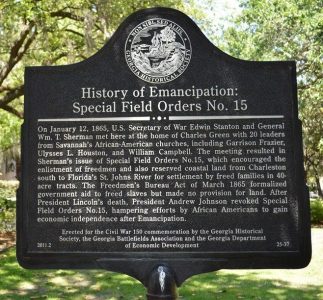Special Field Order No. 15; The Freedmen’s Bureau, the road to continue reconstruction
“On January 16, 1865, during the Civil War (1861-65), Union general William T. Sherman issued his Special Field Order No. 15, which confiscated as Union property a strip of coastline stretching from Charleston, South Carolina, to the St. John’s River in Florida, including Georgia’s Sea Islands and the mainland thirty miles in from the coast. The order redistributed the roughly 400,000 acres of land to newly freed Black families in forty-acre segments.
On January 12 Sherman and Stanton met with twenty Black leaders of the Savannah community, mostly Baptist and Methodist ministers, to discuss the question of emancipation. Lincoln approved Field Order No. 15 before Sherman issued it just four days after meeting with the Black leaders. From Sherman’s perspective the most important priority in issuing the directive was military expediency. It served as a means of providing for the thousands of Black refugees who had been following his army since its invasion of Georgia. He could not afford to support or protect these refugees while on campaign.
The order explicitly called for the settlement of Black families on confiscated land, encouraged Freedmen to join the Union army to help sustain their newly won liberty, and designated a general officer to act as inspector of settlements. Inspector General Rufus Saxton would police the land and work to ensure legal title of the property for the Black settlers. In a later order, Sherman also authorized the army to loan mules to the newly settled farmers.
The Freedmen’s Bureau, as it came to be called, was authorized to give legal title for forty-acre plots of land to Freedmen.
The immediate effect of Sherman’s order provided for the settlement of roughly 40,000 Black Americans (both refugees and locals who had been under Union army administration in the Sea Islands since 1861). This lifted the burden of supporting the Freedpeople from Sherman’s army as it turned north into South Carolina. But the order was a short-lived promise for Blacks. Despite the objections of General Oliver O. Howard, the Freedmen’s Bureau chief, U.S. president Andrew Johnson overturned Sherman’s directive in the fall of 1865, after the war had ended, and returned most of the land along the South Carolina, Georgia, and Florida coasts to the planters who had originally owned it. The Federal government dispossessed tens of thousands of Black landholders.“
